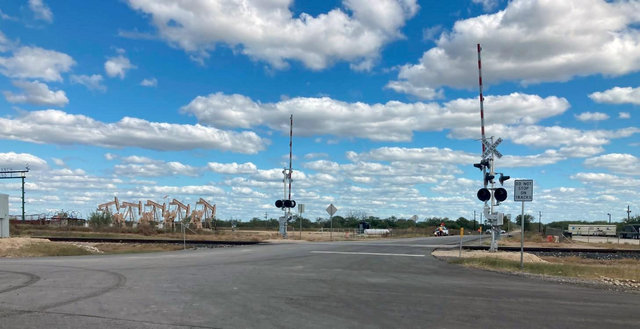
April 8, 2022
Make the Call: Unsafe Motorist Reporting Makes an Impact

Promoting public safety at the busy crossing has required vigilance on the part of Union Pacific employees and local community members – throughout the last decade, both have diligently reported unsafe motorist activity to the railroad’s Response Management Communications Center (RMCC).
Thanks to this reporting activity and proactive assistance from local elected officials, LaSalle County Commissioners and the Texas Department of Transportation, the road authority obtained funding to perform a crossing diagnostic and implement the resulting recommendations, including installing active traffic control warning devices (automatic crossing gates and flashing light signals).
“This is a perfect example of what unsafe motorist reporting can bring,” said Buck Russel, senior supervisor-Public Safety, Law. “The South Texas Service Unit professionals and community members who took the time to report unsafe motorists were a driving factor with local elected officials, encouraging the road authority to move forward with crossing enhancements.”
The selection of signal need and type at grade crossings is made by public agencies with jurisdictional authority.
Driver Rail Safety Tips
Union Pacific reminds drivers to always expect trains travelling from either direction at all railroad crossings. Trains can take more than a mile to stop – after locomotive engineers apply emergency brakes. The following tips will help ensure drivers arrive to their destinations safely.
- Slow down, look both ways and proceed if your entire vehicle can clear the railroad crossing.
- If a train approaches, stop at least 15 feet from the nearest rail. Trains are three feet wider than the tracks on both sides.
- Do not drive around lowered gates – saving a few minutes is not worth risking your life.
- Look again at crossings with multiple tracks. Two tracks may mean two trains – ensure all tracks are clear before driving across each rail line.
- If your car stalls or stops on the crossing, get yourself and all passengers out and away quickly. Call the phone number posted at the railroad crossing or 911 to report a stalled vehicle.

Remember: At crossings, trains can't stop quickly or steer out of the way. Drivers can.
See Driver Rail Safety Tips for more information.
Union Pacific’s Public Projects group is the primary point of contact for local communities and public agencies developing and working on public projects. Public projects may include public or private crossings, crossing surface renewals, road reconstruction at crossings, over- or underpasses, signalized crossing projects and recreational trails. Union Pacific Railroad’s Public Projects Manual is a guide to assist communities, highway agencies and other authorities, industries or private entities to coordinate, plan and implement construction projects involving railroad property.